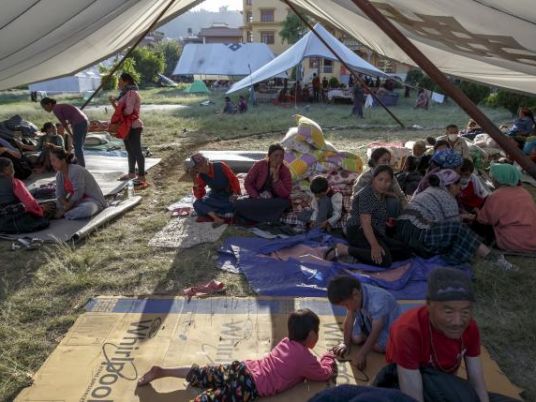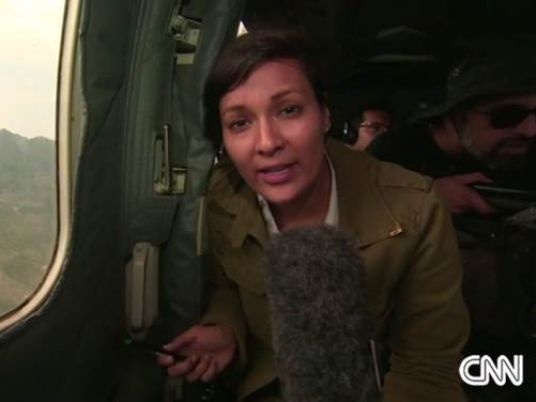
It was three foreign trekkers who used their satellite telephone to call the rescue helicopter that landed in Nepal's Langtang Valley around midday on Tuesday, April 28. Three days earlier, a 7.8 magnitude earthquake had triggered a catastrophic landslide that buried hundreds of people in one village in the valley.
But villagers clung to the chopper's landing skids, preventing it from taking off, witnesses said. They then led the uninjured foreign trekkers out of the aircraft and carried injured Nepalis aboard, including a toddler with broken legs, at a rescue in another village, Kyanjin Gompa.
"Most helicopters were coming to pick up the foreigners, who were healthy, not our injured people," said Lhakpa Jangba, a local baker who was interviewed at a monastery in Kathmandu after his evacuation from the valley last week.
"We said to the foreigners, 'You are healthy. Stay one or two more days and let our injured people go.’"
Rescue workers are struggling to recover the bodies of nearly 300 people, including about 110 foreigners, believed to be buried under up to six metres (20 feet) of ice, snow and rock from the landslide that destroyed Langtang village. So far, the bodies of nine foreigners have been recovered. That makes Langtang one of the worst-hit sites in a disaster whose toll throughout Nepal has reached 7,759 dead with over 16,400 injured.
Langtang Lirung, the 7,234-metre (23,734 feet) mountain looming over the Langtang Valley, shook violently, survivors recalled. It then shed a gigantic slice that fell hundreds of feet, launching a massive torrent of air, snow, ice and rock upon the village and its 55 guesthouses, brimming with trekkers at the start of the climbing season.
The stunning landscapes of Langtang Valley, the nearest Himalayan region to Kathmandu, which lies 60 km (35 miles) to the south, make it popular with foreign climbers and trekkers.
This is the second successive year a catastrophe on the roof of the world has disrupted the climbing season. Last year, sherpas threatened a boycott of Mt. Everest expeditions after 16 were killed in an avalanche on the perilous Khumbu icefall. Eighteen died at Everest Base Camp in April's quake. It's a big business: Everest expedition companies charge clients between $40,000 (26,344 pounds) and $90,000, (59,274 pounds)depending on the number of guides and other services they want. Sherpas can make as little as $1,000 in a whole season.
Those who come to the Langtang Valley are a mix of experienced climbers and adventure trekkers.
"Everest is for very specialised, skilled climbers, while those in Langtang were people on adventure holidays – most without any guides," said Prachanda Man Shrestha, a former head of Nepal’s tourism department. "Anyone can get to Langtang, you are walking at high altitude, but if you are reasonably fit you can go there."
'Subterranean universe'
US mountaineer Kevin Krogh was filming people fleeing a shaking guest house in Kyanjin Gompa in the Langtang Valley in the midst of the quake. The video abruptly ends with people looking back towards the Langtang Himal range as a foggy cloud enters the frame.
Krogh, 32, and his wife, Kat Heldman, 40, had left Langtang village early Saturday morning with the rest of their party for the three-hour trek to Kyanjin Gompa.
The quake was "like nothing I've ever seen in California", real estate broker Heldman told Reuters in a telephone interview from her home in San Diego after her evacuation.
"We see this giant cloud of white. It was moving very fast – we knew it was an avalanche. Our guide screamed: 'Avalanche, run!' We ran through the town as fast as we could, but you can't outrun an avalanche."
Heldman said she ran about 100 feet before diving behind a wall just as the juggernaut of ice, rock and snow caught up to her. She crouched down, putting up her arms "so that I know which way is up if I'm buried". Someone else came up behind her and she grabbed onto him until the avalanche ended. "When it stopped, and it did stop, we could stand up. He had lost his shoes."
She looked around and saw Krogh digging out another member of their party, Oscar Olea. "If you were on the wrong side of a building, you were going to get buried," Heldman said.
She ran into the guest house to get some rescue gear, past a British trekker. "His face was totally bloody – just standing there holding this baby. He gave it to the mother."
Frightened yaks and horses wandered around "a subterranean universe – all grey and white", she recalled.
Her party had hired two guides from a Nepali company called Expedition Himalaya, along with two cooks and 15 porters. They had intended to climb the majestic 6,387-metre (19,680 feet) Gangchempo peak in Langtang National Park.
Instead, they set up a triage station and a dining tent and went in search of the missing. The fellow climber shown on Krogh's video fleeing from the guest house, nurse Brigida Martinez, treated a number of head wounds after the avalanche. The group had 12 days of food for their expedition that they intended to share with survivors.
Under the overhang
Toyanath Rijal was just outside Langtang Village scouting for a location to build a mobile telephone tower when the quake knocked him and three colleagues off their feet.
First, he said he heard a sound like thunder, then an almighty crack. He turned to see a chunk of rock and ice sliding down the mountain, sweeping away everything before it. "It was like watching a wave crashing down the hillside," said Rijal, 40, interviewed in Dhunche, a town in the foothills of Langtang National Park and the base for recovery operations in Langtang.
The landslide was so powerful it travelled across a plateau below the mountain range, over a river and up the other side of the valley, he said.
Rijal watched all this from under a 40-foot high slab of overhanging rock where he had scrambled for shelter with his colleagues.
When the avalanche passed, Rijal fell to his knees clutching his upanayana, the sacred thread devout Hindus wear around their neck, and wept. "I have been given another opportunity in life and there must be a reason for that," he said. "I'm going to use it."
He spent the next three nights living in the open, scavenging for food and firewood around the smothered landscape of Langtang Village, where only one building was left partly standing.
Social media for the missing
Back in California, Kat Heldman's sister Caroline began calling satellite phone numbers that she obtained from Expedition Himalaya as soon as she heard about the earthquake in Nepal that Saturday, April 25. "I begged her expedition company to give me whatever satphone numbers they knew of in the region for guides," Caroline Heldman said in email interview from Los Angeles, where she is a political science professor at Occidental College. "I called them one after another until I found her."
Thirty hours later, calling almost nonstop, she finally got through to Oscar Olea, the climber her sister's husband had dug out of the avalanche at Kyanjin Gompa. "I didn't even know I was talking to him at first. I didn't know they were there. Honestly, according to their itinerary, I thought they were buried in Langtang Village."
On the other end of the line, Kat Heldman was also disoriented. "It took me a while to realise who was calling… that was the first time she knew that we were alive."
It was only then, when Caroline updated her with the news of the quake, that Kat said she realized the extent of the disaster.
Caroline quickly figured out that many families, authorities and even embassies might be in similar predicaments in trying to trace those missing in Nepal. So she started a #Langtang hashtag on Twitter and a Langtang Survivors/Missing group on Facebook. She helped create a Google doc that could be shared among users and listed 440 names – 80 of which were missing at one point. The number of missing has since fallen as survivors were found and victims recovered and identified.
Separate camps
The first rescue helicopter landed in Kyanjin Gompa on Monday, April 27, two days after the quake, carrying away a half-dozen injured, mainly from the village.
The second helicopter came the following day, called in by the three foreign climbers. That was one that the villagers prevented from flying until it took the injured on board.
More helicopters came in the hours and days ahead, each mobbed by village people desperate to get out, said Kat Heldman.
"All the mountaineers that had gear and tents and food adopted the trekkers that didn't have food," she said.
Noted American alpinist Colin Haley, who was two weeks into a climbing trip in the area, set up a water source for the climbers camp on an open plateau.
The villagers camped in a separate area from the climbers, by a garbage dump, because it was sheltered by a large boulder. "But we would go to them to treat their wounds," Heldman said. "Eventually they started coming to us. There was a lot of hugging."
Heldman and her group were evacuated the Wednesday following the quake. "Our party was initially broken up but we refused to go without our porters."
A US Special Forces team in Nepal contracted a six-seater helicopter four days after the quake. Panicky survivors grabbed their bags and ran towards helicopters as soon as they landed, said Dan, a rescue coordinator who spoke on condition that his family name not be used.
"They had mountains on two sides and avalanches on the other. So you can imagine the fear. They realised they couldn't get out unless someone came to get them."
After the fog cleared
Lhakpa Jangba, 34, the baker from Kyanjin Gompa who witnessed the disputes between villagers and trekkers over the helicopter rescues, was caught up in the avalanche that hit the Heldman party. He sat weeping among a hundred or more other evacuated Nepalis sheltering beneath tarpaulins on the grounds of a Buddhist monastery in Kathmandu as he recalled his week-long ordeal.
He too heard the explosion on the mountain and saw the fog rolling down. Within seconds it was upon him. "We had no chance to run. I felt the snow hitting me on the back. It swept everything away – houses, people, horses."
Joining a group of foreign climbers, he headed towards Langtang village. Two sherpas carried a climber with a broken back. They stopped not far from Langtang village. "The fog cleared and I could see that the whole of Langtang was gone."
Lhakpa and a group of 80 or 90 survivors – most of them women, children and the elderly – camped out in the valley. They then returned to Kyanjin Gompa, waiting for rescue helicopters and sometimes squabbling with the foreigners.
As of Thursday, at least 300 people had been rescued from the Langtang Valley, said Gautam Rimal, assistant chief district officer. Lhakpa said he thinks many people died of their injuries in the valley because not enough helicopters arrived in time.
Villagers had "strong words" with the pilots and foreigners, but there was no violence, Lhakpa said. "Whoever survives has to unite. There is no other option."
The villagers in Kyangjin Gompa were grateful to an American nurse and climbing group who treated many of their injured, Lhakpa said, apparently referring to Brigida Martinez and the Heldman group. "Our minds were lost. We were half-dead, half-alive."



